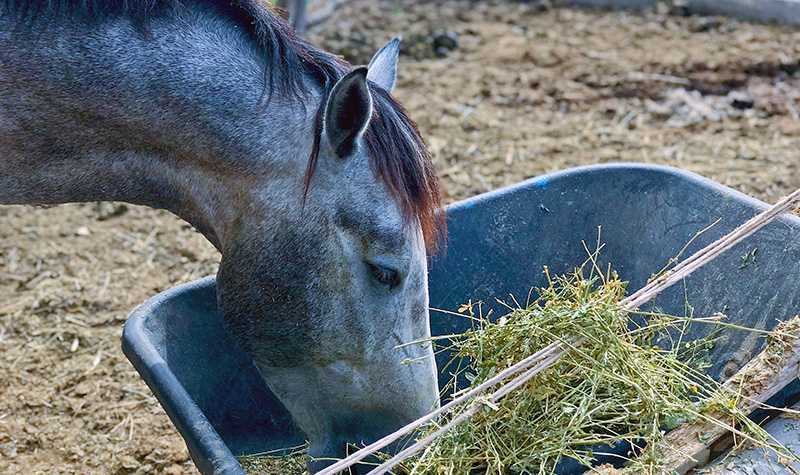Horses of every discipline and lifestyle may develop ulcers in their gastrointestinal tract, leading to poor appetite, poor performance, and possible colic. Dr. Rebecca Bishop, an equine veterinarian who is completing a PhD at the University of Illinois College of Veterinary Medicine in Urbana, researches equine gastrointestinal health. She explains that there are two types of equine gastric ulcer syndrome, which occur in different locations of the stomach.
Equine Squamous Gastric Disease
Equine squamous gastric disease (ESGD) develops in the portion of the stomach nearest the mouth. Squamous cells, which are thin and flattened, line the stomach here, similar to the tissue lining the esophagus in people.
“This tissue has minimal physical barrier to protect it from acidic gastric contents,” says Dr. Bishop. “Horses acquire ulcers in this portion of the stomach when stomach acid comes into direct contact with the lining, similar to gastric reflux in people.”
Horses are at a greater risk for ESGD if they participate in activities that increase the sloshing of stomach contents, such as intense exercise, or acidity of the stomach, such as fasting or feeding grain.
Equine Glandular Gastric Disease
The second portion of the horse’s stomach has a glandular lining, similar to a human stomach. These glands secrete digestive enzymes and acid to break down food as well as protective mucous and bicarbonate to protect the lining from the acid. Ulcers present in this portion of the stomach are referred to as equine glandular gastric disease (EGGD). The cause of ulcers in this portion of the equine stomach is not known.
“This area is designed to be exposed to acidic gastric contents, but we think that EGGD occurs when normal defense or healing mechanisms are disrupted,” says Dr. Bishop. Non-steroidal anti-inflammatories, such as phenylbutazone (“bute”) or flunixin meglumine (Banamine®), can increase a horse’s risk of EGGD. Other factors that have been shown to influence a horse’s risk of EGGD include frequency of exercise, breed, and experience level of the horse, according to Dr. Bishop.
Impact and Management of Gastric Ulcers
Gastric ulcers can cause severe disease in affected horses, regardless of breed, use, or discipline. “Both ESGD and EGGD can cause inappetence, colic, and poor performance, including but not limited to ‘girthy’ behavior, biting, and bucking. Ulcers therefore negatively affect the horse’s wellbeing and the bond with their owner,” says Dr. Bishop.
Managing horses with any kind of equine gastric ulcer syndrome is focused on decreasing the risk factors described above. Proper feeding practices can significantly reduce a horse’s risk for squamous gastric ulcers.

“Feeding of a forage-based diet, without large grain meals, and limiting the time when the horse is without access to feed are two strategies for maintaining the stratification (layers) of gastric contents and minimizing acid exposure,” Dr. Bishop explains. “A hay diet, especially high-protein hay such as alfalfa, is associated with increased intragastric pH and decreased incidence of gastric ulcers.”
According to Dr. Bishop, hay should always be available to horses, even prior to exercise. When horses are fed hay before exercise, there is a decrease in the amount of gastric content splashing and therefore a decrease in stomach acid injuring the squamous lining. Another mitigation technique is limiting non-steroidal anti-inflammatory use.
Stress is another factor that increases a horse’s risk of both types of gastric ulcers. Dr. Bishop recommends decreasing stress through consistency. Two examples are maintaining a consistent feeding and exercise routine and limiting social stress by having consistent turnout groups, when possible.
“A gastroprotectant medication may be considered during times of stress, such as illness, shipping, showing, and NSAID administration,” says Dr. Bishop, “especially for horses with a history of equine gastric ulcer syndrome.”
Study Compares Effectiveness of Anti-Ulcer Medications
Recently, Dr. Bishop led a study at the University of Illinois evaluating the effectiveness of two common medications used to prevent equine gastric ulcer syndrome. Healthy horses were fasted and given non-steroidal anti-inflammatories according to a pre-determined schedule, mimicking conditions that might be experienced by a horse with colic. The horses received either GastroGard®, an omeprazole-based gastroprotectant which functions by decreasing the acidity of stomach contents, or sucralfate, which acts as a “band-aid” by binding to ulcerated areas to decrease symptoms.
“We found that ESGD and EGGD worsened over time under both treatments, but that ESGD and EGGD scores were higher when horses received sucralfate compared to GastroGard®. From this, we concluded that GastroGard® was superior for mitigation of equine gastric ulcer syndrome in healthy horses exposed to the stressors of fasting and NSAIDs.”
However, Dr. Bishop says that further research should be done using horses with clinical disease.
By Alaina Lamp
Featured photo by Alejandra Rodríguez on Unsplash




